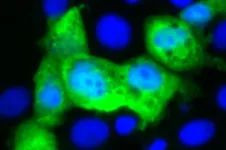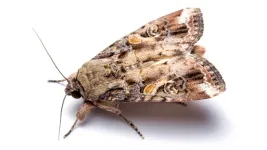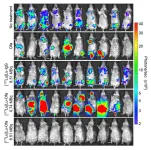(Press-News.org)
“To our knowledge, this is the first functional study of POLDIP2 in retinal cells to understand its potential role in AMD.”
BUFFALO, NY- April 11, 2023 – A new research paper was published in Aging (listed by MEDLINE/PubMed as "Aging (Albany NY)" and "Aging-US" by Web of Science) Volume 15, Issue 6, entitled, “Knockout of AMD-associated gene POLDIP2 reduces mitochondrial superoxide in human retinal pigment epithelial cells.”
Genetic and epidemiologic studies have significantly advanced our understanding of the genetic factors contributing to age-related macular degeneration (AMD). In particular, recent expression quantitative trait loci (eQTL) studies have highlighted POLDIP2 as a significant gene that confers risk of developing AMD. However, the role of POLDIP2 in retinal cells such as retinal pigment epithelium (RPE) and how it contributes to AMD pathology are unknown.
In this new study, researchers Tu Nguyen, Daniel Urrutia-Cabrera, Luozixian Wang, Jarmon G. Lees, Jiang-Hui Wang, Sandy S.C. Hung, Alex W. Hewitt, Thomas L. Edwards, Sam McLenachan, Fred K. Chen, Shiang Y. Lim, Chi D. Luu, Robyn Guymer, and Raymond C.B. Wong from Royal Victorian Eye and Ear Hospital, University of Melbourne, St Vincent’s Institute of Medical Research, University of Tasmania, and The University of Western Australia report the generation of a stable human RPE cell line ARPE-19 with POLDIP2 knockout using CRISPR/Cas, providing an in vitro model to investigate the functions of POLDIP2.
“We conducted functional studies on the POLDIP2 knockout cell line and showed that it retained normal levels of cell proliferation, cell viability, phagocytosis and autophagy. Also, we performed RNA sequencing to profile the transcriptome of POLDIP2 knockout cells.”
Their results highlighted significant changes in genes involved in immune response, complement activation, oxidative damage and vascular development. They showed that loss of POLDIP2 caused a reduction in mitochondrial superoxide levels, which is consistent with the upregulation of the mitochondrial superoxide dismutase SOD2. In conclusion, this study demonstrates a novel link between POLDIP2 and SOD2 in ARPE-19, which supports a potential role of POLDIP2 in regulating oxidative stress in AMD pathology.
“In summary, we have generated a POLDIP2 knockout ARPE-19 cell line using CRISPR/Cas9 and studied the biological functions of POLDIP2. To our knowledge, this is the first functional study of POLDIP2 in retinal cells to understand its potential role in AMD.”
Continue Reading: DOI: https://doi.org/10.18632/aging.204522
Corresponding Author: Raymond C.B. Wong
Corresponding Email: wongcb@unimelb.edu.au
Keywords: age-related macular degeneration, retina, CRISPR/Cas, mitochondria superoxide, POLDIP2
Sign up for free Altmetric alerts about this article: https://aging.altmetric.com/details/email_updates?id=10.18632%2Faging.204522
About Aging-US:
Launched in 2009, Aging publishes papers of general interest and biological significance in all fields of aging research and age-related diseases, including cancer—and now, with a special focus on COVID-19 vulnerability as an age-dependent syndrome. Topics in Aging go beyond traditional gerontology, including, but not limited to, cellular and molecular biology, human age-related diseases, pathology in model organisms, signal transduction pathways (e.g., p53, sirtuins, and PI-3K/AKT/mTOR, among others), and approaches to modulating these signaling pathways.
Please visit our website at www.Aging-US.com and connect with us:
SoundCloud
Facebook
Twitter
Instagram
YouTube
LabTube
LinkedIn
Reddit
Pinterest
Click here to subscribe to Aging publication updates.
For media inquiries, please contact media@impactjournals.com.
Aging (Aging-US) Journal Office
6666 E. Quaker Str., Suite 1B
Orchard Park, NY 14127
Phone: 1-800-922-0957, option 1
###
END
Every year, norovirus causes hundreds of millions of cases of food poisoning — and the deaths of at least 50,000 children — yet there exists no real way to control it. The virus has proven exceptionally difficult to study in the lab, and scientists have struggled to develop effective vaccines and drugs.
A new study at Washington University School of Medicine in St. Louis describes a creative way to make a vaccine against norovirus by piggybacking on the highly effective vaccines for rotavirus, an unrelated virus that also causes diarrhea.
The ...
ITHACA, N.Y. – The demand for battery-grade lithium, nickel, cobalt, manganese and platinum will climb steeply as vehicle electrification speeds up and nations work to reduce greenhouse gas emissions through mid-century. This surge in demand will also create a variety of economic and supply-chain problems, according to new Cornell University research published in Nature Communications.
In the new paper, senior author Fengqi You, professor in energy systems engineering, and his colleagues examined 48 countries that are committed to playing a strong role in electrifying transportation, including the U.S., China and India.
Under ...
As announced today in a press release by biotechnology company Treventis, global pharmaceutical company Takeda has agreed to exclusively license a group of small molecules that target tau – a protein in which misfolding and aggregation are believed to be a cause of Alzheimer’s disease.
The molecules were developed by the team at Treventis, building upon the Alzheimer’s & neurodegenerative research expertise of Dr. Donald Weaver’s lab at UHN.
“There are currently no effective drugs out there that target tau in the brain,” says Dr. Donald Weaver, Senior ...
New York, NY (April 11, 2023) – A study led by Mount Sinai researchers Dr. Bin Zhang, the Willard T.C. Johnson Research Professor of Neurogenetics, and Dr. Christian Forst, an Associate Professor in the Department of Genetics and Genomic Sciences, have identified potential novel receptors for SARS-CoV-2 and unveiled their tissue-specific and age-dependent expression. The findings were published on March 23 in the Federation of European Biochemical Societies Letters.
The study's multiscale network analysis suggests that SARS-CoV-2 utilizes multiple novel receptors, such as the TYOBP receptor CD300e, to facilitate ...
North Carolina State University researchers have shown that adding a small amount of a chemical used in perfumes – nonanal – to a two-chemical combination of other sex pheromones helped increase the cocktail’s effectiveness in mimicking female fall armyworm “come hither” calls to males.
The findings could eventually help farmers better detect, monitor and control fall armyworm populations, which negatively affect some 350 plant species – including crops like corn and cotton as well as turfgrass and other cultivated grasses.
“Nonanal is emitted ...
Pests and diseases may reduce global wheat yields by over 20%. A study published April 11th in the open access journal PLOS Biology by Sergio Latorre at University College London, UK and colleagues suggest that genomic surveillance may be an effective disease management tool with the ability to trace lineages of emerging crop diseases, and to identify genetic traits for breeding disease-resistant lines.
Wheat crops across the globe are threatened by wheat blast, an emerging fungal disease. However, disease-management strategies have been unsuccessful. In order to better understand ...
ITHACA, N.Y. -- A Cornell multidisciplinary research center that studies chronic fatigue syndrome has received a five-year, $9.5 million grant from the National Institutes of Health’s National Institute of Allergy and Infectious Disease – funding that will enable experts from disparate fields to work together on the mysterious and debilitating condition.
The Cornell Center for Enervating Neuroimmune Disease, established in 2017, ultimately seeks to understand the biological ...
New Haven, Conn. — Omicron subvariants of SARS-CoV-2 — the virus behind COVID-19 — have shown an uncanny knack for evading antibodies produced either by vaccines or exposure to earlier versions of the virus, leading to many breakthrough infections. However, in order to sicken people, these viral variants must also avoid “killer” T cells, immune cells that are unleashed when the immune system detects foreign pathogens.
A new Yale study published April 10 in the Proceedings of the National Academy of Sciences reveals new insights into how these Omicron variants are able to avoid destruction by these T cells.
For the study, ...
At a glance
Dragana Rogulja is using fruit flies and mice to explore tantalizing questions about sleep.
Her research delves into why sleep is necessary for survival, and how the sleeping brain disconnects from the world.
Rogulja’s research has identified a critical connection between the brain and the gut.
If translated into humans, the results of her work could lead to new ways for improving sleep and reducing damage from sleep deprivation.
Sleep is one of the most essential human activities — so essential, in fact, that if we don’t get enough sleep for even one ...
Reston, VA—A new nuclear medicine therapy can cure human non-Hodgkin lymphoma in an animal model, according to research published in the April issue of The Journal of Nuclear Medicine. A single dose of the radioimmunotherapy, [177Lu]Lu-ofatumumab, was found to quickly eliminate tumor cells and extend the life of mice injected with cancerous cells for more than 221 days (the trial endpoint), compared to fewer than 60 days for other treatments and just 19 days in untreated control mice.
Non-Hodgkin lymphoma is a common blood malignancy. The ...




